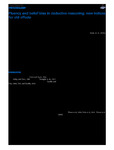Fluency and belief bias in deductive reasoning: new indices for old effects
| dc.contributor.author | Trippas, D | |
| dc.contributor.author | Handley, SJ | |
| dc.contributor.author | Verde, MF | |
| dc.date.accessioned | 2020-10-19T12:09:32Z | |
| dc.date.available | 2020-10-19T12:09:32Z | |
| dc.date.issued | 2014 | |
| dc.identifier.issn | 1664-1078 | |
| dc.identifier.issn | 1664-1078 | |
| dc.identifier.other | ARTN 631 | |
| dc.identifier.uri | http://hdl.handle.net/10026.1/16557 | |
| dc.description.abstract |
Models based on signal detection theory (SDT) have occupied a prominent role in domains such as perception, categorization, and memory. Recent work by Dube et al. (2010) suggests that the framework may also offer important insights in the domain of deductive reasoning. Belief bias in reasoning has traditionally been examined using indices based on raw endorsement rates-indices that critics have claimed are highly problematic. We discuss a new set of SDT indices fit for the investigation belief bias and apply them to new data examining the effect of perceptual disfluency on belief bias in syllogisms. In contrast to the traditional approach, the SDT indices do not violate important statistical assumptions, resulting in a decreased Type 1 error rate. Based on analyses using these novel indices we demonstrate that perceptual disfluency leads to decreased reasoning accuracy, contrary to predictions. Disfluency also appears to eliminate the typical link found between cognitive ability and the effect of beliefs on accuracy. Finally, replicating previous work, we demonstrate that cognitive ability leads to an increase in reasoning accuracy and a decrease in the response bias component of belief bias. | |
| dc.format.extent | 631- | |
| dc.format.medium | Electronic-eCollection | |
| dc.language | eng | |
| dc.language.iso | eng | |
| dc.publisher | Frontiers Media SA | |
| dc.subject | reasoning | |
| dc.subject | belief bias | |
| dc.subject | signal detection theory | |
| dc.subject | memory | |
| dc.subject | individual differences | |
| dc.title | Fluency and belief bias in deductive reasoning: new indices for old effects | |
| dc.type | journal-article | |
| dc.type | Article | |
| plymouth.author-url | https://www.ncbi.nlm.nih.gov/pubmed/25009515 | |
| plymouth.issue | JUN | |
| plymouth.volume | 5 | |
| plymouth.publication-status | Published online | |
| plymouth.journal | Frontiers in Psychology | |
| dc.identifier.doi | 10.3389/fpsyg.2014.00631 | |
| plymouth.organisational-group | /Plymouth | |
| plymouth.organisational-group | /Plymouth/Faculty of Health | |
| plymouth.organisational-group | /Plymouth/Faculty of Health/School of Psychology | |
| plymouth.organisational-group | /Plymouth/REF 2021 Researchers by UoA | |
| plymouth.organisational-group | /Plymouth/REF 2021 Researchers by UoA/UoA04 Psychology, Psychiatry and Neuroscience | |
| plymouth.organisational-group | /Plymouth/REF 2021 Researchers by UoA/UoA04 Psychology, Psychiatry and Neuroscience/UoA04 Psychology, Psychiatry and Neuroscience MANUAL | |
| plymouth.organisational-group | /Plymouth/Research Groups | |
| plymouth.organisational-group | /Plymouth/Research Groups/Centre for Brain, Cognition and Behaviour (CBCB) | |
| plymouth.organisational-group | /Plymouth/Research Groups/Centre for Brain, Cognition and Behaviour (CBCB)/Cognition | |
| plymouth.organisational-group | /Plymouth/Users by role | |
| plymouth.organisational-group | /Plymouth/Users by role/Academics | |
| dc.publisher.place | Switzerland | |
| dcterms.dateAccepted | 2014-06-03 | |
| dc.identifier.eissn | 1664-1078 | |
| dc.rights.embargoperiod | Not known | |
| rioxxterms.versionofrecord | 10.3389/fpsyg.2014.00631 | |
| rioxxterms.licenseref.uri | http://www.rioxx.net/licenses/all-rights-reserved | |
| rioxxterms.licenseref.startdate | 2014 | |
| rioxxterms.type | Journal Article/Review |


